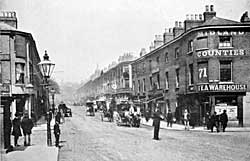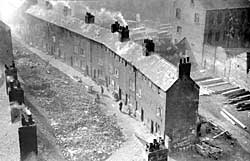< Previous | Contents | Next >
Canal Street and Leenside

Junction of Carrington Street and Canal Street, c.1890.
CANAL STREET which extends all the way from the junction of Wilford Road with Castle Boulevard to Leenside, into which it runs opposite Lees Yard, is not a particularly old thoroughfare. It was formed in the year 1796 and previous to that all the land to the south until one reached the river Trent was open country. Its run is more or less along the southern boundary of the property of the Grey Friars which, as we have seen was situated outside the fortifications of the mediaeval town. The river Leen flowed along here until 1829 when it was arched over. There was a bridge which was called Dyehouse Bridge over the Leen just opposite the end of Sussex Street and the roadway up to this point was along the south bank of the river. The Leen here took a turn in a southerly direction and the road proceeded along its northern bank until Leen Side and eventually London Road was reached. The modern Canal Street was formed in 1880 and has proved an exceedingly valuable artery for traffic.
There is not much history connected with this street which is rather surprising as there were a number of wharfs leading from the canal abutting on to it and in one of these wharfs a really serious catastrophe occurred in 1818. The wharf belonged to the Nottingham Boat Company and its site was adjoining what is now the Canal Street Bridge probably about where the Bridge Buildings are at present situated. A boatload of gun powder was in transit from Gainsborough for use in the Derbyshire mines and had paused in Nottingham and was drawn up underneath the warehouse of the company. The cargo consisted of twenty-one barrels of powder each barrel containing over 100 lbs. The head of one of these barrels appears to have been faulty and some of the powder fell out and remained scattered about the wharf edge. This somehow or other became ignited and a terrible explosion occurred in which no fewer than sixteen people were killed and a vast amount of damage was done to property.
Just beyond Sussex Street is a good old-fashioned red brick house standing back a few yards from the roadway and fronted by a courtyard surrounded by a palisade. Its number is 73. In this house in the year 1819 was born Dean Gregory a most interesting and philanthropic character. His father was a leading Wesleyan associated with Halifax Place Chapel and engaged in the business of cotton doubling and dealing. Robert Gregory who was afterwards to become Dean of St. Paul's commenced his life by being apprenticed to a firm of merchants in Liverpool with whom he was thoroughly grounded in the principals of business routine and in the science of management and organisation. In 1850 he was ordained after a somewhat brilliant career at Oxford. He became a widower and took up work as curate of St. Mary's Church, Lambeth where he remained for two years. He afterwards became vicar of the desperately poor parish of St. Mary the Less, Lambeth, where he laboured with great success for twenty years. So important was the work that he did and so valuable were his services to the community at large through his work upon various external committees, that Mr. Gladstone placed his son, the Rev. Stephen Gladstone, with him as his curate. Robert Gregory was made a Canon of St. Paul's in 1868 and was made Dean in 1894 and the period of his office will always be remembered for it was during that time that the services of the Cathedral were re-organised and a start was made with beautifying Wren's masterpiece. He died in 1911 leaving behind him the memory of a long and well spent life.

Leenside during the clearance schemes of the 1930s.
LEENSIDE is a continuation of Canal Street, but of course is a much older road, for we have found it to be the back road which gave access to the long strips of land at the back of the Narrow Marsh houses. In it, just about its juncture with Canal Street was situated one of the town mills which was called the Malt Mill. This was one of several of the mills upon the river Leen. The flow of this river is interesting. It rises near Newstead Abbey and it used to join the Trent near the end of the modern Trent Lane, in fact some traces of its ancient bed may still be discovered in the fields by the side of that lane. At some early period, probably before the Conquest, this flow was diverted in order to bring the Leen to Nottingham so that its power might be used to turn the town mills. The new course ran close along the cliff to the south of the Park until it reached the Hermitage where was settled a body of Religious of such importance that the flow of the river was turned to the south to avoid disturbing them. Up to this point only one bank was necessary but for the rest of its distance a double bank was needed as it had to leave the foot of the cliff. It passed directly under the Castle rock and was used as we shall see in later times by the occupants of the Castle and it turned a mill somewhere about the foot of the Castle rock. It then flowed along Canal Street and Leenside and eventually turning in a southerly direction reached the Trent a couple of miles away from its ancient mouth. The mill in Leenside which we are considering was placed astride of the stream which shows that it was contemporary with the diversion of the current thus proving its age. The church of St. John the Baptist was founded in 1843. The foundation stone was laid by Earl Manvers and an address was delivered to the onlookers by Archdeacon Wilkins. It was completed in 1844 and the architects were Messrs. Scott & Moffat. It has been very much admired by some and said to be typical of Sir Gilbert Scott's revived Gothic, but its surroundings are such that it is extremely difficult to get a view of it and to form any architectural judgment upon it.
Speaking of views, one of the most striking views in the whole of Nottingham may be obtained from the junction of Bridge Street, and Leenside. Here, if one looks up on the magnificent tower of St. Mary's perched upon its cliff with the wilderness of city roofs round it and glimpses here and there of strange old dwellings and warehouses, one is forcibly reminded of the view from Durham Bridge, and I always wish that there could be some notice put up hereabouts to call attention to the truly magnificent prospect.
Plumtree Hospital which is situated at the eastern side of Plumtree Square was founded in 1392 while Richard II. was on the throne, by John de Plumtree, who was sometime Mayor of Nottingham and who lived in a house whose site is now occupied by the Flying Horse Hotel, the gardens of which stretched right down to St. Peter's Gate. John de Plumtree dedicated his hospital to the Blessed Virgin Mary and decreed that it was for the sustenance of "thirteen poor widows broken down of age and depressed by poverty." It was rebuilt in 1560, two years after Queen Elizabeth came to the throne, by Huntingdon Plumtree, and was enlarged in 1753. The present buildings were erected in 1823. Nottingham may be justly proud of this hospital for it is one of the very few of the ancient charities which escaped the great pillage under Edward VI. in 1547, whereby the endowments of nearly all charities were swept away. The trustees under Plumtree's will and their successors must have been extremely efficient for so well were they managing their hospital that even Edward's Commissioners, who were on the look out for every possible excuse for confiscation, could find no reason for taking possession of their estates.
There is nothing particularly interesting about the present buildings, but the grassy courtyard at the rear of the hospital is a very pleasant oasis in the midst of the roaring traffic of the neighbourhood.
